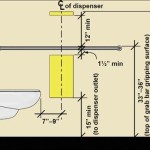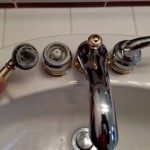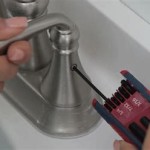Ideas for Bridging the Gap Between Your Bathroom Vanity and Wall
The often-overlooked gap between a bathroom vanity and the wall can present both aesthetic and practical challenges. It's a space that can accumulate dust, debris, and even moisture, potentially leading to mold growth. Furthermore, a visible gap can detract from the overall cohesiveness and polished look of the bathroom design. This article explores a variety of solutions for addressing this gap, focusing on both functional and decorative approaches.
Understanding the Cause of the Gap
Before exploring solutions, it's crucial to understand why the gap exists in the first place. Several factors can contribute to this issue. Uneven walls are a common culprit, particularly in older homes where walls may not be perfectly plumb. The vanity itself might not be perfectly square, especially if it's a budget-friendly or older model. Installation errors, such as failing to account for wall irregularities, can also lead to gaps. Finally, variations in plumbing placement can sometimes necessitate pushing the vanity slightly away from the wall.
Accurately diagnosing the cause will inform the most effective solution. If the wall is significantly uneven, simply caulking the gap might not be sufficient. In such cases, a more substantial approach, such as shimming the vanity or addressing the wall's unevenness directly, may be required.
Practical Solutions: Sealing and Filling the Gap
One of the most common and straightforward solutions for addressing the gap between a vanity and the wall is to seal it with caulk. Caulk provides a waterproof barrier, preventing moisture and debris from entering the space. It's available in a variety of colors to match the vanity or surrounding wall, ensuring a seamless appearance. Silicone caulk is generally recommended for bathroom applications due to its superior water resistance and flexibility.
When applying caulk, it's important to first clean the surfaces thoroughly. Remove any existing caulk, dirt, or mildew. Apply the caulk in a smooth, even bead, using a caulking gun. Immediately after application, smooth the caulk with a wet finger or a caulking tool for a professional finish. Allow the caulk to dry completely according to the manufacturer's instructions before exposing it to water.
For larger gaps, simply filling with caulk might not be feasible or aesthetically pleasing. In these situations, consider using backer rod. Backer rod is a foam material that is inserted into the gap before applying caulk. It provides a solid backing for the caulk, preventing it from sinking into the gap and requiring excessive amounts of caulk. It also ensures a more uniform and durable seal.
An alternative to caulk is using a trim piece, such as quarter-round or a strip of wood. This approach offers a more substantial and often more visually appealing solution, particularly for wider gaps. The trim piece can be painted or stained to match the vanity or surrounding décor. This method provides a cleaner, more finished look than simply caulking a large gap. The trim piece should be attached securely to either the vanity or the wall using adhesive or small finishing nails.
When choosing a trim piece, consider the style of the bathroom and the vanity. A more ornate trim piece might be appropriate for a traditional bathroom, while a simple, clean line might be better suited for a modern space. It's also important to ensure that the trim piece is water-resistant or properly sealed to protect it from moisture damage.
Decorative Solutions: Integrating the Gap into the Design
Instead of simply trying to hide the gap, consider incorporating it into the overall bathroom design. This approach can turn a potential problem into a unique design feature. One option is to create a small shelf or niche in the gap. This can provide additional storage space for toiletries or decorative items. A custom-built shelf can be designed to perfectly fit the gap, maximizing its functionality and visual appeal. The shelf can be made from wood, glass, or other materials to complement the bathroom's style.
Another decorative solution is to use the gap to conceal lighting. Installing LED strip lights behind the vanity can create a soft, ambient glow that enhances the overall atmosphere of the bathroom. This approach is particularly effective for creating a relaxing and spa-like environment. The lighting can be controlled by a dimmer switch to adjust the intensity as needed.
Plants can also be used to fill the gap and add a touch of nature to the bathroom. A small potted plant can soften the hard lines of the vanity and wall, creating a more inviting space. Choose plants that thrive in humid environments and low light conditions, such as ferns or orchids. Artificial plants are also an option for those who prefer a low-maintenance solution.
Mirrors can visually expand a small bathroom and can be creatively used to address vanity gaps. A narrow, vertical mirror positioned in the gap can create the illusion of more space and add a stylish touch. The mirror can be framed or frameless, depending on the desired aesthetic. Consider using a beveled mirror for added visual interest.
A less common, but potentially impactful solution involves commissioning custom-built storage elements to fill the gap. This approach allows for seamlessly integrated additional storage, tailored to the exact dimensions of the remaining space. These elements could range from narrow pull-out shelves for cleaning supplies to compartmentalized units designed to organize toiletries. The custom-built approach ensures a perfect fit and maximizes the utility of the often-wasted space.
Addressing Significant Wall Irregularities
In situations where the wall is significantly uneven, simply filling or covering the gap might not be a long-term solution. In these cases, it's necessary to address the wall's unevenness directly. This can involve patching and leveling the wall with drywall compound. Apply the compound in thin layers, allowing each layer to dry completely before applying the next. Sand the compound smooth to create a level surface.
Another option is to install shims behind the vanity to level it. Shims are thin pieces of wood or plastic that are placed between the vanity and the wall. They can be used to adjust the vanity's position and create a flush fit against the wall. Use a level to ensure that the vanity is perfectly straight before securing it in place.
For extreme cases, it may be necessary to consult with a contractor to repair the wall. This could involve removing and replacing damaged drywall or reinforcing the wall structure. While this is a more costly and time-consuming solution, it can provide a permanent fix and ensure the long-term stability of the vanity.
Sometimes, the issue is not the wall itself, but an obstruction such as a pipe or electrical conduit that prevents the vanity from sitting flush. Relocating these obstructions, while potentially complex and requiring professional assistance, can be a viable solution for achieving a seamless fit. A plumber or electrician can assess the feasibility and cost of relocating these elements. This approach guarantees a more permanent resolution compared to just covering the obstruction's impact on vanity placement.
Finally, if the vanity is much smaller than the space it occupies, consider replacing it with a larger vanity. This is the most drastic solution, but it can completely eliminate the gap and create a more visually balanced bathroom. Choose a vanity that is appropriately sized for the space and complements the overall style of the bathroom. Thoroughly measuring the area is crucial before purchasing a new vanity to ensure a proper fit.

Nice Little Shelves To Fill The Gap Between Vanity And Wall In Small Bathroom Diy Remodel Room Decor Apartment

How To Fix This Gap Between Vanity And Wall Backsplash Countertop Bathroom Tops

Vanity Wall Gap Filler Bathroom Storage Solutions Small Remodel

Big Gap Between Vanity And Wall

Alcove Vanity Flush To Walls Or Ok Have Space On Sides

The Question Of Vanity View Along Way

Bathroom Vanity Between Two Walls Just In Place Renovation

New Bathroom Vanity Counter Not Square Wall Ideas
Gap Between Wall And Bathroom Vanity Wondering If I Can Tile Ceramic Advice Forums John Bridge

Pin On Home
Related Posts







